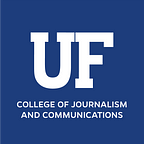A Nazi on Campus: When Two Wrongs Don’t Make a Right
By John Freeman
Associate Professor of Journalism
University of Florida College of Journalism and Communications
Two ugly incidents occurred yesterday in Gainesville, Fla., my home for the past 25 years.
A man dressed in black and wearing a Nazi swastika armband drew a crowd of 200 protesters at the University of Florida campus. What was his message and why was he here? That’s hard to say. He stood mostly silent during a four-hour visit to Turlington Plaza, generally considered a free-speech zone on campus.
His presence implied a message of hate. He was met with vulgar chants of condemnation. That was ugly enough, but the second incident was worse. After University police escorted him away at his request, two men in a red pickup truck attacked the man on a city sidewalk. They stole his jacket and armband, and then escaped. (Today, two men were arrested for assault on Michael Dewitz, 34, according to the news site wuft.org.)
As a photographer-turned-professor with more than 40 years of experience in journalism, yesterday’s events reminded me of my first encounter with campus activism. The Vietnam War was a heated topic when I arrived at the University of Missouri in fall 1971. Students rallied at the Francis Quadrangle in the middle of campus. Long-haired students dressed in bell-bottoms and U.S. Army fatigue jackets shouted “Hell, no, we won’t go!” for months because a government-mandated draft was about to send young men off to war in Southeast Asia. As a young, aspiring photojournalism student, demonstrations were gold mines to photograph.
At Thursday’s rally on the UF campus, the overriding chant was “No more Nazis — never again.” The man in black had incited the crowd with a couple of Nazi salutes, according to early participants at the gathering. Without a professional camera hanging from my shoulder this time, I moved in closer with an iPhone. I flashed back to my college days. News was happening.
My Connection to the Nazi Issue
I am familiar with the concept of hating Nazis. Having lived in Berlin for three impressionable years during high school as a military brat, I know of the atrocities against the Jews and others who did not fit Hitler’s mold of the perfect race. That perception has been reinforced during the 12 subsequent years of study-abroad courses I have led to Berlin. Germans are good at apologizing for their dark past.
College students visiting Berlin are often overwhelmed at the massive “Memorial to the Murdered Jews of Europe.” The open-air site is a sobering arrangement of 2,711 gray columns that tilt and lean in an arrangement meant to be disorienting. With cobblestone walkways that seem to sink and rise randomly, visitors lose sight of their surroundings among the taller columns. Do the gray structures represent tombstones? Are they coffins? Architect/Designer Peter Eisenman, an American, says the meaning of the memorial is open to interpretation. Yet all know the site is a statement against Nazism.
The Spin of News and Social Media
While news organizations in Gainesville reported objectively on Thursday’s gathering at UF’s Turlington’s Plaza, some failed to mention a UF professor blasting the stoic and calm Dewitz with a double-barreled finger-salute and angry “F-U!” shout-out inches from his face. While I am not Jewish and cannot relate to the professor’s rage, it was one of the uglier moments of the event.
On social media, where posters originally made calls against the swastika armband, replies switched to praises for the men who jumped Dewitz and made off with his jacket.
“Great example of a community defending itself. Keep up the good work, and to the red truck heroes: Good Job!” read a comment by “Eric” on the wuft.org site. “This is the legal defense fund for the men who ‘allegedly’ attacked him. They are facing unnecesarily (sic) harsh felony charges. lets show our support for these young men!” wrote Xander.
UF president Kent Fuchs addressed the issue in various forums. While recognizing the issue of free speech and reporting that Michael Dewitz could not be removed from campus, he wrote to faculty, staff and students: “As the University of Florida continues to support the peaceful gathering of students at Turlington Plaza in response to the man with a swastika on his armband, I want to be clear that I do not accept such symbols of hate.”
The Day After
With curiosity, I approached another call for a noon rally today at the site of yesterday’s demonstration and protest. A variety of speakers primarily of the Jewish faith addressed the crowd without mentioning Thursday’s incidents. They acknowledged that today, Jan. 27, is International Holocaust Remembrance Day, an international memorial day commemorating the victims of the Holocaust. The speakers called for unity among all Americans — blacks, white, Jews, disabled and transgendered. In light of the ugliness of Thursday, the rally was refreshing, especially the brief surprise appearance of UF president Kent Fuchs, who echoed the speakers’ concerns.
As a low-keyed singing of John Lennon’s “Imagine” filled the plaza, I looked around at the diversity in the crowd: students, faculty, staff, reporters and passersby. Young and old. Jews and non-Jews. But no Nazi supporters were among those who hugged and sang together today.
As the refrain of “Imagine” brought the rally to a close, President Fuchs wiped a tear from his eye and turned to leave. A rousing chant of “It’s great — to be — a Florida Gator!” spread through the crowd. A smile returned to Fuchs’s face as he waited to address local media.
Yesterday’s ugly incidents were behind us.
